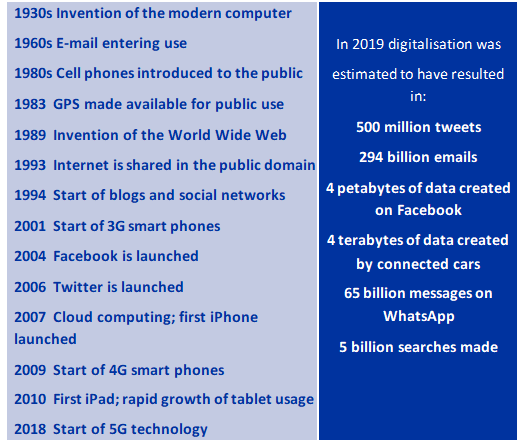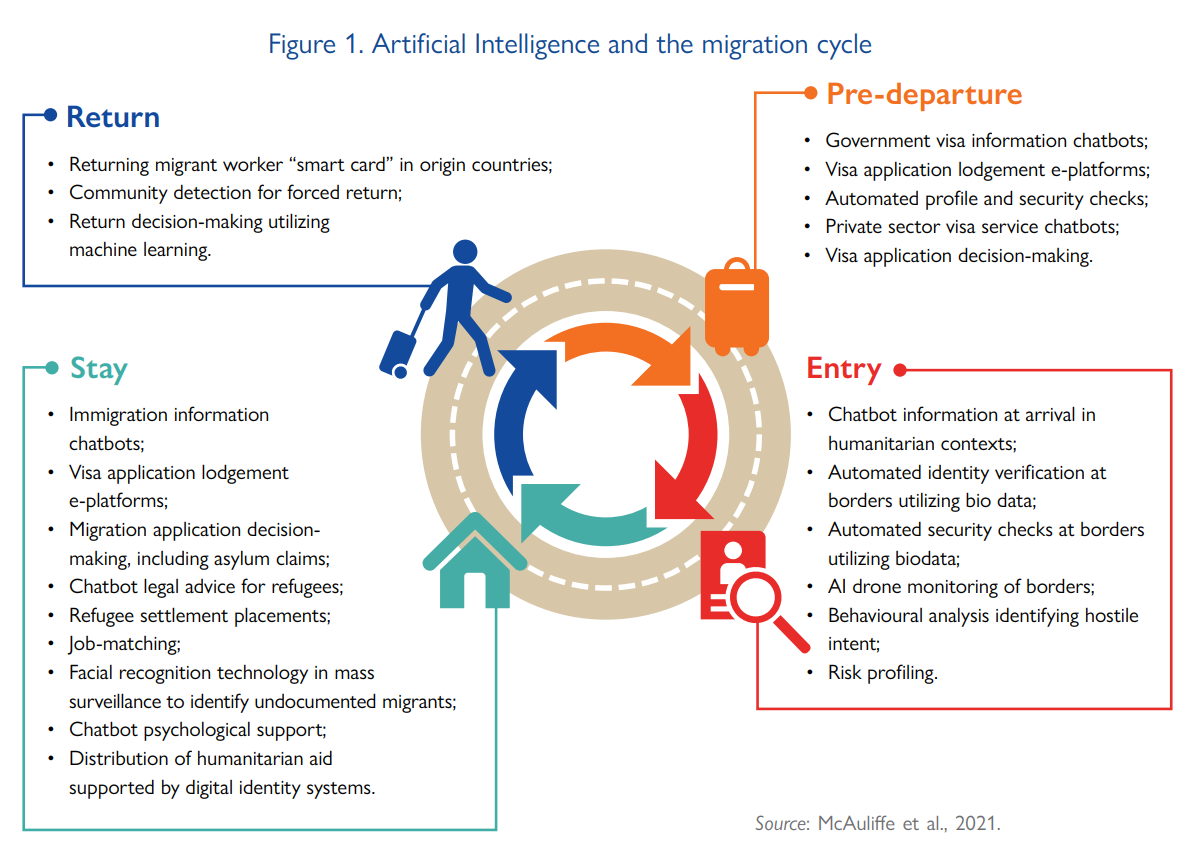Digital technology and migration
What is digital technology?
The concept of digital technology has historically been closely related to computer technology, and in particular advances in computerisation and increasing reliance on computers in human and machine labour from the mid-twentieth century onwards. However, digital technology is broader, encompassing computer technology and non-computer technological innovations, such as those associated with smart phones and other devices. Related, digitalisation involves the creation of digital records or versions of all sorts of materials, such as paper/electronic documents and other information, photos, videos, music and other audio, biometric scans/imagery. [Excerpt from Chapter 1 “International migration and digital technology: An overview” by Dr. Marie McAuliffe in the Research Handbook on International Migration and Digital Technology]
Digitalisation of telecommunications over the last century

The rise and expansion of digital technology is a characteristic of the Fourth Industrial Revolution “velocity, scope, and systems impact” that is deeply transforming the way we live.
Earlier industrial revolutions relate to advances in the use of steam/water for mechanization (1700s), electricity for mass production (1800s), early computers for early digitalisation (from 1950s).
Key resources on the topic
- Report Overview — technological transformations (WMR 2024, Ch. 1%2C%20Geneva.-,World%20Migration%20Report%202024%3A%20Chapter%201%20%2D%20Report%20overview%3A%20Migration,world%2C%20but%20key%20challenges%20remain&text=International%20migration%20is%20a%20complex,aspects%20all%20around%20the%20world.))
- Artificial Intelligence, migration and mobility (WMR 2022, Ch. 11)
- Mobility, Migration and Transnational Connectivity (WMR 2018, Ch. 6)
- Research Handbook on International Migration and Digital Technology
Digitalisation and migration
Digital technology is increasingly used throughout the ‘migration cycle’:
- Pre-departure: migrant decision making and preparation; visa information (e.g chatbots); visa application processing/e-lodgement; risk profiling
- Entry: passport/visa technologies; border technologies (e.g. drones); biometric/identity related capture; behavioral risk analysis; apps to facilitate movement by migrants
- Stay: connectivity to support transnational families (e.g. ICT apps, mobile money); integration services (e.g. online, apps, chatbots), international advocacy (e.g. human rights’ groups)
- Return and reintegration: return migration analysis & assistance (e.g. ‘smart cards’); data dossiers on undocumented migrants
- Migration, technology and public debates: Mis- and disinformation
- Analysing migration dynamics: digital technology in migration research and analysis
How are digitalization and artificial intelligence (AI) related?
AI technologies rely on underlying data capture and digital capabilities in order to be applied. “Digitalization” of aspects of migration systems is, therefore, a necessary condition for the application of AI technologies. However, digitalization does not necessarily result in AI technologies being developed and implemented. Compared with digitalization, AI in migration and mobility is currently much more limited.

Bridging migrants’ gender digital divide**
Today’s digital society, accelerated by the COVID-19 pandemic, raises considerable gender inequalities: women and girls constitute the majority of the estimated 2.7 billion people worldwide who are unconnected, with major variations in women using the Internet across least developed and developed countries. For migrants, access to and usage of digital solutions and digital literacy and skills often depend on connectivity in their country of origin, and on gender roles, as digital tools may be associated with men in the household division of labour.
A number of initiatives have been adopted to decrease the gender digital divide worldwide, from basic digital skills development to STEM education programmes for women, including migrants and refugees. As the leader in new technological developments and digitalization, the private sector is important in fostering gender digital inclusion. In the financial sector, some financial technology companies are moving towards migrant-centric and gender-smart designs for digital remittances that are affordable, accessible and promote financial resilience. Among other similar initiatives, and together with the United Nations Capital Development Fund, Ping Money - a financial technology company licensed in the United Kingdom and funded by Gambian migrants, offering digital remittances services to migrants from the Gambia - has worked on formalizing remittances channels, including by offering the possibility for migrants in the United Kingdom to directly pay water and electricity bills for their families in the Gambia and launching a mobile wallet for families receiving remittances. A comprehensive market scanning revealed gender differences in Gambian households, with women less aware of mobile money. Considering gender dynamics at play — whereby information tended to reach women through their male relatives more effectively - Ping Money launched a brand awareness campaign through football sponsorships, the main sport in the Gambia. This not only resulted in increasing the number of men clients but also that of women who were encouraged to use mobile money services by their men relatives.
COVID-19 impacts on automation and the changing role of labour mobility in the global economy
Growing digital transformation has major effects on migrants and migration processes. Because of the pandemic, migrants now increasingly rely on digital sources for information and remittance transfers while governments increasingly rely on new digital systems to manage migration. Adapting to online service provision has been a key focus during the pandemic health crisis, especially to cater to migrant populations and other vulnerable groups. For example, 14 out of 27 European Union countries adopted or switched to online health-care service provision, including videos and tutorials in different languages, as well as online consultations. While these integration technologies can support migrant populations, the designs, development and implementation of these technologies must centre human rights, and human rights must not be restricted by the limits of technical feasibility.
Meanwhile, increasing digital transformation is itself partially a result of changing migration and mobility trends due to the pandemic. For example, a key impact of movement restrictions has been to drastically reduce labour supplies to major economic centres. In the international context, this means fewer immigrants to the main destination countries, while in the domestic context it means fewer internal migrants and commuters to dense urban areas. These reduced levels of migration and mobility have led to extremely tight labour markets in cities across the developed world. In theory, a smaller supply of immigrant labour should lead to higher wages in destination regions. It should come as little surprise therefore that many labour economists have declared the post-pandemic period a golden era for workers, involving plentiful job vacancies, rising wages, so-called “quiet quitting” (in which employees put less effort into their work), and a “great resignation”.
Challenges and opportunities
Technology may enable capabilities and function as an equalizer of societal disparity. For example, digital identity initiatives may provide excluded individuals, such as migrants and refugees who cannot prove legal identity, with the means to open a bank account and access a variety of services in a host country.
The increasing datafication of migration and mobility can create and magnify vulnerabilities. Datafication refers to the different types of data, including biometric, satellite and big data, which are increasingly collected, stored and used for migration management. Poor data storage practices and cybersecurity flaws can expose migrants sensitive information.
There are advantages in using AI in the context of border security and migration management. AI systems can analyse vast amounts of data, including big data, to identify patterns and predict behaviour. AI algorithms can thus increase efficiency by streamlining repetitive tasks that depend on the review of large amounts of data. AI technologies are frequently used for visa and asylum processing and decision-making. A key advantage of using AI systems is that they can speed up visa and asylum application processing while screening for security threats and reducing irregular migration.
AI systems can however amplify existing human biases, not just encode them. This can ultimately lead to discrimination and exclusion of people based on protected characteristics, including race and ethnicity. Bias is a common issue that permeates AI systems in a variety of sectors. Therefore, AI systems need to be developed in a way that deliberately and systematically seeks to remove or reduce bias throughout the process, from data collection and analysis to the reporting and assessment stages.
One of the key aspects currently underpinning analysis is the extent to which a lack of transparency dominates. To some extent, this is likely to be fuelled by the risk of malicious acts of cybersecurity to undermine or control AI systems. However, this in itself creates different risks, especially as they relate to the erosion of human rights.
Reflection questions
What does the fourth industrial revolution refer to?
Describe how digitalisation impacts migrants throughout the migration cycle. Please provide two examples.
Briefly explain two reasons why digital technology and AI in migration processes raises concern.
Describe one initiative that aims to combat the gender digital divide.
How have digital transformations during COVID-19 effected migrants and migration processes?